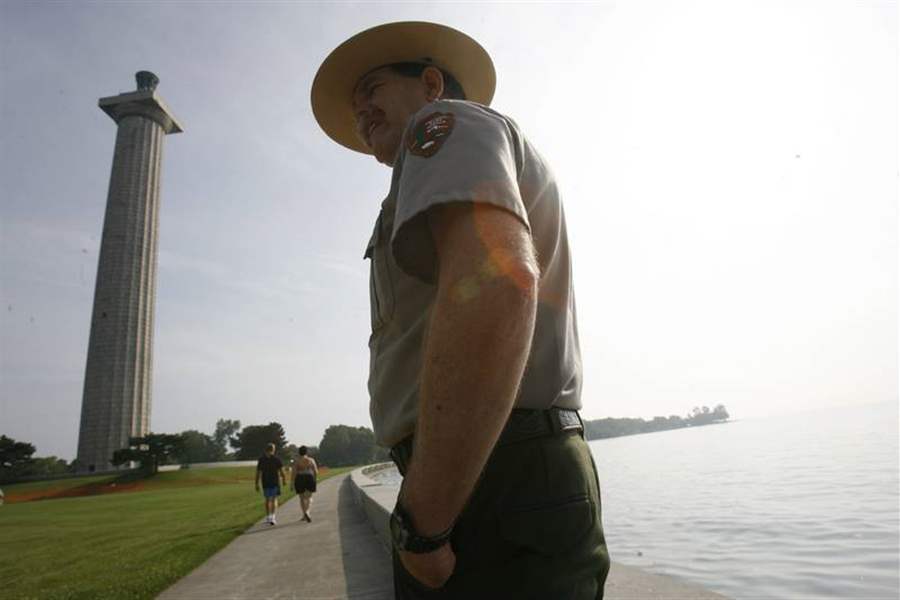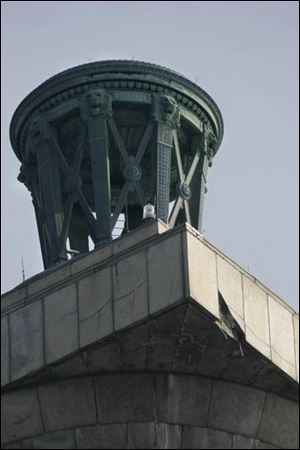
Time chips away at Perry memorial
7/23/2006
Andy Ferguson, superintendent of Perry's Victory and International Peace Memorial, says an upcoming inspection could help determine whether the monument can be safely reopened.

A chunk of stone fell from near the tower's top last month.
PUT-IN-BAY, Ohio - Perry's Victory and International Peace Memorial, the symbol of the 135-year disarmament of the U.S.-Canadian border, is falling apart.
A slab of granite that broke off from the observation deck of the Lake Erie landmark is just the most visible sign of its deterioration. The stone's 300-foot plunge punched a hole through the plaza.
"I would not characterize [the condition] as good," said Mike LeBorgne, chief of the construction management division in the National Park Service's Denver office. "Any monument where the stones are falling out is a less than acceptable condition."
The June 22 incident was the second time in the monument's history that a piece of granite fell onto the plaza and into the foundation room.
Largely unseen is deterioration caused by harsh winters and water seeping into stone and the mortar holding it together.
Extensive renovation was last performed in 1980-82, when the monument was closed to repoint 3 1/2 miles of joints, renovate the observation gallery, and replace some concrete in the walls and upper plaza.
New repair work was planned in preparation for bicentennial celebrations six years from now.
But that 500-pound chunk added urgency to those plans.

Andy Ferguson, superintendent of Perry's Victory and International Peace Memorial, says an upcoming inspection could help determine whether the monument can be safely reopened.
"It definitely has gotten the attention of the park system in the Washington Support Office," Mr. LeBorgne said.
The 352-foot Doric column on South Bass Island, three miles from the mainland, was completed in 1915 to commemorate the Battle of Lake Erie, an 1813 American victory over the British during the War of 1812. The naval victory paved the way for the eventual disarmament of the border and the Great Lakes.
"It's one of our icons. We definitely will be moving to restore and to have any repairs done by [the bicentennial]," Mr. LeBorgne said.
The support office handles projects that cost more than $1 million and generally require several years of planning.
"It takes about two to three years for a project to hit a major construction program," he said. "We'll be funding it and moving as quickly as we possibly can."
Repairs could cost between $10 million and $15 million, but Mr. LeBorgne said that's strictly a guess. A more thorough inspection is planned in September when the extent of the monument's deterioration can be assessed.
There's no doubt that serious renovations will be necessary.
On Tuesday, a group of engineers who specialize in inspecting buildings and monuments with hard-to-reach areas such as steeples, domes, towers, chimneys, and high parapet or screen walls will be on South Bass Island to inspect damage.
Engineers from Vertical Access will strap on harnesses and climb over the parapet to examine each of the 52 fascia stones along the observation deck.
Andy Ferguson, the Park Service's superintendent at the monument, said that the inspection could help determine whether the monument can be safely reopened.
Short-term fixes that will stabilize the Perry monument to allow its reopening are handled by another division of the National Park Service and are expected to begin once engineers finish examining the damaged fascia piece. Mr. Ferguson said he hopes a temporary, hardened tunnel can be installed that would allow visitors to reach the entrance and the elevator to the observation gallery.
Mr. Ferguson calls Perry's Victory and International Peace Memorial sacred ground.
Beneath the rotunda's white and black marble floor is a crypt with the bodies of three American and three British officers who died in the Battle of Lake Erie. They were buried the day after the battle in what is now DeRivera Park at Put-in-Bay.
On Sept. 11, 1913, the centennial of the battle, the six officers were reinterred inside the peace memorial.
Along with the dead, the monument honors the legacy of the battle and the long-lasting peace that ensued between the two nations. "A shared 4,000-mile, undefended border is unique," Mr. Ferguson said.
At this point, he doesn't know whether the short-term repair plan is feasible or when the rotunda and observation deck will be reopened.
To see the monument's hidden damage, you have to go through the locked doors that guard the entrance to the foundation room under the plaza.
The foot-thick ceiling bears traces of water seepage from above. Water seeps through cracks in the mortar from 78 layers of granite slabs that encircle the monument.
The water carries with it minerals and particles of stone and mortar. It drips from the ceiling, walls, and piping, forming stalactites the thickness of a pencil.
At least one stalagmite grows up from a concrete walk that circles the column's 45-foot diameter base.
Mr. Ferguson said the mineral deposits are evidence of the monument's deterioration. Some cracks are finger-width.
"We have some very harsh winters here," he said.
The lake's freeze-thaw cycle, coupled with heat and wind in summer, wears down the monument.
Behind the granite slabs, which weigh between 2 and 5 tons each, is a poured concrete column. The inner walls above the rotunda are lined with brick.
In the meantime, orange plastic safety netting surrounds the plaza to keep the curious out of danger. A chain-link fence with barbed wire is planned because of occasional incursions by trespassers.
Away from the monument itself, it's business as usual for the park service and its programs, guided by a staff of 25 rangers and seasonal employees.
Each year, about 154,000 people visit the site. Many take the $3 elevator ride to the top for a dynamic view of the surrounding islands, the mainland, and 10 miles to the battle site.
While the monument itself is closed, events that would have been held next to it are being staged near the visitors' center.
"We still going full tilt," Mr. Ferguson said. "We are still open."
Contact Jim Sielicki at: jsielicki@theblade.com or 419-724-6078.